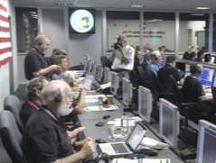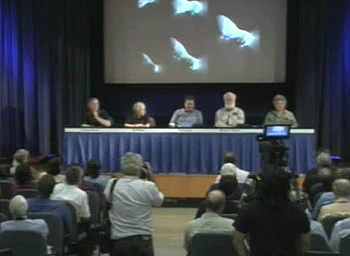EPOXI
Two intriguing investigations -- One flight-proven spacecraft
News: UMD Leads Deep Impact Spacecraft on Successful Flyby of Comet Hartley 2, 2010.11.04
Press Release
UMD Leads Deep Impact Spacecraft on Successful Flyby of Comet Hartley 22010.11.04
COLLEGE PARK, Md. - The University of Maryland-led EPOXI mission successfully flew by comet Hartley 2 at 10 a.m. EDT today, and the spacecraft has begun returning images. Hartley 2 is the fifth comet nucleus visited by any spacecraft and the second one visited by the Deep Impact spacecraft.
 Click for larger image.
Comet Hartley 2 as seen by the Deep Impact Flyby.
Click for larger image.
Comet Hartley 2 as seen by the Deep Impact Flyby.
Credit: NASA/JPL-Caltech/UMD
At a post-encounter press conference, University of Maryland scientists said initial images from the flyby provide new information about the comet's volume and showed that plumes of material spewing from its surface were largely generated by jets of CO2 gas.
"Early observations of the comet show that, for the first time, we may be able to connect activity to individual features on the nucleus," said University of Maryland astronomer Michael A'Hearn, one of the originators of, and science team leader for, both the Deep Impact mission and its follow on mission EPOXI. ."We certainly have our hands full. The images are full of great cometary data, and that's what we hoped for.."
At approximately 10 a.m. EDT, the spacecraft passed within 700 kiloeters (435 miles) of the comet. Minutes after closest approach, the spacecraft's High-Gain Antenna was pointed at Earth and began downlinking vital spacecraft health and other engineering data stored aboard the spacecraft's onboard computer during the encounter. Twenty minutes later, the first images of the encounter made the 37 million kilometer (23 million mile) trip from the spacecraft to NASA's Deep Space Network antenna, appearing moments later on the mission's computer screens.
 UMD's Michael A'Hearn (bottom left) and other EPOXI team members in JPL mission control after closest flyby.
UMD's Michael A'Hearn (bottom left) and other EPOXI team members in JPL mission control after closest flyby.
Credit: NASA/JPL-Caltech/UMD
"The mission team and scientists have worked for this day," said Tim Larson, EPOXI project manager at NASA's Jet Propulsion Laboratory, Pasadena, Calif. "It's good to see Hartley 2 up close."
A Deeper Impact on Planetary Science
With the latest EPOXI mission data on Hartley 2, the Deep Impact spacecraft is adding to an already extensive scientific legacy. Launched in January 2005, the spacecraft made scientific history and world-wide headlines when it smashed a probe into comet Tempel 1 on July 4th of that year. Following the conclusion of that mission, a Maryland-led team of scientists won approval from NASA to fly the Deep Impact spacecraft to a second comet.
 NASA EPOXI News Conference segment with University of Maryland Astronomy Professors Mike A'Hearn and Jessica Sunshine.
NASA EPOXI News Conference segment with University of Maryland Astronomy Professors Mike A'Hearn and Jessica Sunshine.
Credit: NASA/JPL-Caltech/UMD
The name EPOXI itself is a combination of the names for the two extended mission components: the extrasolar planet observations, called Extrasolar Planet Observations and Characterization (EPOCh), and the flyby of comet Hartley 2, called the Deep Impact Extended Investigation (DIXI). During the EPOCh phase of EPOXI, the Deep Impact spacecraft provided information on possible extrasolar planets and was one of three spacecraft to find for the first time clear evidence of water on Moon. Another contribution of EPOXI is a study accepted for publication in The Astrophysical Journal that was just released by NASA. It provides "colorful" findings on Earth and other planets in our solar system that someday may help identify earthlike worlds around other stars.
The overall objective of the flyby of Hartley 2 is the same as that for the Deep Impact mission's trip to Tempel 1: to learn more about the origin and history of our solar system by learning more about the composition and diversity of comets. Comets contain material from the early days of the solar system before the planets formed. "If we understand the comets really well it will tell us how the planets got made," explained A'Hearn. "That's why we choose comets to study."
NASA's Jet Propulsion Laboratory, Pasadena, Calif., manages the EPOXI mission for NASA's Science Mission Directorate, Washington. The University of Maryland, College Park, is home to the mission's principal investigator, Michael A'Hearn and eight other members of the EPOXI science team. Drake Deming of NASA's Goddard Space Flight Center, Greenbelt, Md., is the science lead for the mission's extrasolar planet observations. The spacecraft was built for NASA by Ball Aerospace & Technologies Corp., Boulder, Colo.
Lee Tune
University of Maryland, College Park
301-405-4679
ltune [at] umd [dot] edu
DC Agle
Jet Propulsion Laboratory, Pasadena, Calif
818-393-9011
agle [at] jpl [dot] nasa [dot] gov
Dwayne Brown
Headquarters, Washington
202-358-1726
dwayne.c.brown [at] nasa [dot] gov
RELEASE: 10204, Source
